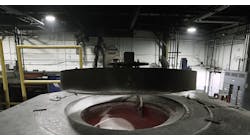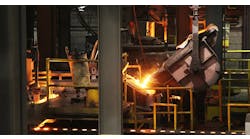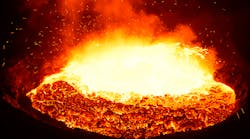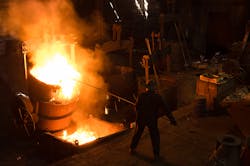All iron melted via conventional techniques contains free-oxygen atoms. The amount of free-oxygen contamination varies depending upon the melting method and materials melted, but some free-oxygen atoms always exist.
Free-oxygen atoms are detrimental to the quality of solidified castings. They offer no benefits – only bad consequences from their presence.
Primary steelmakers deal with free-oxygen atoms’ presence by adding aluminum and other high-oxygen-affinity materials. A foundry or any manufacturer that melts iron cannot employ the same oxygen-atom-eliminating techniques. Iron foundries must seek other methods to control oxidation.
For a very long time iron foundries accepted oxidation as inevitable. Slag formation was thought to be a fundamental part of melting. Oxidation always occurred, and it could not be avoided. Most melt deck managers and operators tried to make the best of a bad situation.
The issue of oxidation has changed. For the first time since the beginning of the Iron Age, about 2500 years ago, iron can be melted without carbon and silicon oxidation losses. It is been shown now that iron melting can occur without oxidation.
The new deoxidizing material, Mastermelt DeOX. DeOX is a silicon carbide-pet coke blend that aggressively attacks the source of free-oxygen atoms – iron oxide – contacting the molten iron bath.
Much has been written recently regarding molten-iron deoxidation during or after the melting cycle, but the end result – de-oxidized iron – presents many metallurgical properties and characteristics that are notable improvements over typical ductile iron or cast iron.
Cleaner iron – less nano-sized suspended oxides. Once the molten iron is de-oxidized, a remarkable new material emerges. Iron without large quantities of suspended nano-sized oxides is a much “cleaner” metal. When the free-oxygen atom supply is cut-off, the Laws of Thermodynamics still apply, meaning the precipitation of the free-oxygen atoms with other elemental atoms in the melt. The subsequent agglomeration and buoyancy of the oxide mass means that those impurities soon attach to the bath’s cover slag layer.
This is a very important point: Molten iron self-cleanses when the supply of free-oxygen atoms is cut-off, and DeOX Metal Treatment accomplishes that. The reaction time for the oxygen atom to unite with some other atom in the molten metal bath is 1-2 minutes, at a maximum. The time for agglomeration to complete is longer, and still unknown at this point.
Total oxygen levels may judge iron quality. Investigation is underway in the attempt to link the cleanliness of iron to total oxygen content, which will enable an on-line production test to qualify iron regarding the properties enhanced by low free-oxygen iron. If total oxygen can be obtained spectrographically, and if a correlation exists between total oxygen and deoxidized iron properties, quality monitoring of gray and ductile iron would be greatly improved.
Cleaner iron is almost a new material, and many other metallurgical qualities are being revealed with the availability of deoxidized molten iron.
Increased ductility. Elongation in deoxidized ductile iron (deoxidized prior to magnesium treatment) exhibits much higher elongation values. Typically, 5-7% minimum higher elongation results have been recorded with deoxidized iron. Some reported increases exceeded 10% elongation. Such an improvement in ductility must not be overlooked.Reduced heat treatment. Annealing heat treatments, undertaken to enhance iron ductility, may possibly be avoided due to the cleaner iron matrix and higher as-cast ductility. Deoxidized iron produces ductility levels that exceed most ductile iron specifications without heat treatment.
Less residual chrome. The reduction in suspended nano-size MgO oxides appears to be more influential than the reductions in chrome-carbide levels. Ductile iron containing 0.25% chrome tested at 19% elongation when the iron was deoxidized prior to magnesium treatment. Without deoxidation, the chrome level needed to be reduced to a maximum 0.12% to attain 10% elongation.
Now, with far more chrome present, elongation doubles when the base iron is deoxidized. The overall view or analysis is that deoxidation limits the amount of suspended magnesium oxides, which have been shown to be more detrimental than chromium carbides.
Reduced magnesium requirements. Eliminating free oxygen in ductile base iron reduces the amount of magnesium tied up as MgO during treatment. Spectrographic analysis for magnesium in treated ductile iron reveals both the free magnesium and that which is tied up as MgO. Removing the free-oxygen atoms prior to the magnesium treatment makes possible full graphite nodularization at lower magnesium levels.
Magnesium required can be reduced by 15% or more, depending on the free-oxygen contamination previously present. The magnesium reduction can be mathematically calculated using concentration levels of free oxygen and atomic weights.
Chemistry stability. Chemistry stability is attained throughout the melting, holding, and casting process. Oxidation losses are eliminated. Chemistry variations encountered with standard melt practices are primarily caused by iron-oxide interaction with the molten iron. With deoxidation, chemistries no longer decline over time. In fact, in one DeOX application, molten iron was held in a 35-ton horizontal drum furnace for 52 days without the carbon or silicon levels changing even a single point. In that instance, the chill wedge poured, without inoculation and after the 52-day hold period, tested at 3/32nds which duplicates that of inoculated iron.
Reduced chemistry testing frequency. In most electric melting foundries, iron chemistry is checked after the initial heat melt-down. Then, chemistry corrections are made to the heat and chemistry is rechecked. That was exactly the procedure used by one of DeOX Metal Treatment customer. The foundry happily reported total chemistry stability, and every heat using identical charges reported identical chemistry. There were no furnace corrections needed once DeOX Metal Treatment began.
Reduced carbide-forming tendencies. De-oxidized iron with free oxygen at its inert level shows minimal carbide-forming tendencies. Think about the 52-day hold period and an un-inoculated chill depth of 3/32nds. Free-oxygen atoms profoundly influence graphite formation and growth. When free oxygen is at inert levels, graphite formation is unimpeded, producing the optimal physical properties in the solidified metal.
Improved graphitization. The graphite-forming tendency inherent to deoxidized iron is phenomenal. Pig iron, used to enhance graphite nucleation, is no longer needed. Higher levels of unwanted residual alloys are possible without creation of detrimental effects.
Improved casting machinability. Suspended oxides within the casting matrix significantly affect machinability, and thus tool wear. Deoxidized iron containing typically 0.25% Cr produces benchmark machinability ratings. Competing non-deoxidized iron was limited to 0.12% Cr and at that level still produced poorer machinability ratings. Deoxidized iron allowed lower-cost metallic scrap iron, producing significant savings.
Stops melting-cycle slag formation. Deoxidation of the melting process stops slag formation in cupola and EF melting. Slag is comprised of by-products of oxidation. When oxidation losses stop, slag formation stops. Significant energy savings go hand-in hand with no slag formation.
DeOx metal treatment saves money. Oxidation losses of carbon, silicon, and manganese are eliminated when the molten iron is deoxidized in the melting process. Full alloy recovery is gained from auxiliary alloy additives, and less carbon, silicon, and magnesium are required.
Eliminate flux added for slag build-up. DeOX stops slag formation. No fluxes are needed for slag control, and no slag is produced. No slag build-ups occur in furnace inlets, outlets, or sidewalls.
No harm to refractory lining. DeOX is a blend of silicon carbide and pet coke. Neither material causes harm to furnace refractory linings. In fact, in vertical channel furnaces DeOX has increased lining life 2-4X by eliminating iron oxide, which is very harmful to refractory, initiating chemical attack and causing erosion.
Fluidity increases. A major attribute of the cleaner metal is improved fluidity during casting. Suspended oxides act as thickeners to the molten iron. The sluggishness of high suspended-oxide iron disappears.
Eliminate ferro-phosphorous additions. Fluidity aids like ferro-phosphorous are no longer required. In some instances, pouring temperatures can be reduced.
Increased strength and ductility. Ductile iron’s tensile, yield, and elongation improve with cleaner base metal. Metal toughness improves.
Stronger cast iron. In cast iron, tensile strength rises 15% with de-oxidation. The cast iron contains fewer suspended oxides which act as crack initiation sites, thereby lowering its tensile strength.
Stop surface slag formation. Deoxidation of the iron melting process stops slag formation during the melt cycle. The melted iron does not continue to fom “surface” slag after the melt cycle completes. Ladles are slag-free. When iron is deoxidized, slag issues disappear.
No casting surface/subsurface defects. Casting defects resulting from oxide formation in the melt are stopped by de-oxidation. Surface and sub-surface defects caused by nano-sized oxide agglomeration and floatation are stopped. Customer casting returns after machining showing oxide floatation defects or pinholes are stopped.
Stop oxide floatation defects. A portion of cast iron scrap results from free-oxygen induced, oxide floatation defects. A major Midwest foundry that previously eliminated deoxidized iron (resulting in higher casting scrap rates) now has reduced its scrap rate from 3% to 1%, having instituted deoxidized iron.
Casting scrap rate reductions have been achieved in every foundry that has implemented iron deoxidation via DeOX Metal Treatment.
Deoxidation is necessary to supplement other quality control programs in place at iron foundries. QC programs can only attain predetermined scrap rate levels. Oxide flotation surface defects can only be stopped by deoxidation. If free-oxygen atom levels are higher than the inert level for a particular molten iron composition, surface defects will always form. The Laws of Thermodynamics control defect formation, which is a force that foundry metallurgists cannot overcome – except by deoxidation, which reduces casting scrap levels to zero.
Ron Beyerstedt is the president of Mastermelt LLC. Contact him at [email protected]










